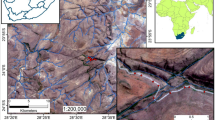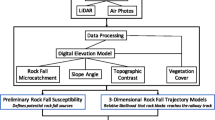Abstract
In this paper a tool for semi-quantitative susceptibility assessment at a regional scale is presented which is applicable at areas with complex geological setting. At a study area within the Northern Calcareous Alps geotechnical mappings were implemented into a Geographical Information System and analysed as grid data with a cell size of 25 m. The susceptibility to sliding and falling processes was considered according to five classes (very low, low, medium, high, very high). Susceptibility to sliding was analysed using an index method. The layers of lithology, bedding conditions, tectonic faults, slope angle, slope aspect, vegetation and erosion were combined iteratively. Dropout zones of rockfall material were determined with help of a Digital Elevation Model. The movement of rolling rock samples was modelled by a cost analysis of all potential rockfall trajectories. These trajectories were also divided into five susceptibility classes. The susceptibility maps are presented in a general way to be used by communities and spatial planners. Conflict areas of susceptibility and landuse were located and can be presented destinctively.











Similar content being viewed by others
References
Acharya G, De Smedt F, Long NT (2006) Assessing landslide hazard in GIS: a case study from Rasuwa, Nepal. Bull Eng Geol Environ 65:99–107
Aleotti P, Chowdhury R (1999) Landslide hazard assessment: summary review and new perspectives. Bull Eng Geol Environ 58:21–44
Ayalew L, Yamagishi H, Ugawa N (2004) Landslide susceptibility mapping using GIS-based weighted linear combination, the case in Tsugawa area of Agano River, Niigata Prefecture, Japan. Landslides 1:73–82
Ayalew L, Yamagishi H, Marui H, Kanno T (2005) Landslides in Sado Island of Japan: Part II. GIS-based susceptibility mapping with comparisons of results from two methods and verifications. Eng Geol 81:432–445
Azzoni A, Rossi PP, Drigo E, Giani GP, Zaninetti A (1991) In situ observation of rockfall analysis parameters. In: Bell H (ed) Landslides, Proceedings of the 6th international symposium on landslides in Christchurch vol 1, New Zealand, pp 307–314
Barredo JI, Benavides A, Hervas J, Van Westen CJ (2000) Comparing heuristic landslide hazard assessment techniques using GIS in the Tirajana basin, Gran Canaria Island, Spain. Int J Appl Earth Obs Geoinf 2(1):9–23
Carrara A, Cardinali M, Guzzetti F, Reichenbach P (1995) GIS-technology in mapping landslide hazards. In: Carrara A, Guzzetti F (eds) Geographical information systems in assessing natural hazards, pp 135–176
Cruden DM, Varnes DJ (1996) Landslide types and processes. In: Turner AK, Schuster RL (eds) Landslides: investigation and mitigation. Special Report 257, Transportation Research Board, National Research Council, pp 36–75
Eisbacher GH, Linzer HG, Meier L, Polinski R (1990) A depth extrapolated structural transect across the Northern Calcareous Alps of western Tirol. Ecol Geol Helv 83(3):711–725
Jenson SK, Domingue JO (1988) Extracting topographic structure from digital elevation data for geographic information system analysis. Photo Eng Remote Sens 54(11):1593–1600
Juang CH, Lee DH, Scheu C (1992) Mapping slope failure potential using fuzzy sets. J Geot Eng 118:475–494
Lee S, Ryu JH, Won JS, Park HJ (2004) Determination and application of the weights for landslide susceptibility mapping using an artificial neural network. Eng Geol 71:289–302
Linzer HG, Ratschbacher L, Frisch W (1995) Transpressional collision structures in the upper crust: the fold-thrust belt of the Northern Calcareous Alps. Tectonophysics 242:41–61
Kassebeer W, Ruff M (2003) Georisikokarte Vorarlberg—Analyse geogener Gefährdungen mit GIS im regionalen Maßstab. In: Strobl J, Blaschke Th, Griesebner G (Eds) Angewandte Geographische Informationsverarbeitung XV, pp 186–195
Moser M, Üblagger G (1984) Vorschläge zur Erstellung von geotechnischen Karten und Erhebungen im Rahmen von Gefahrenzonenplänen in Hangbereichen. Int Symp Interpraevent Villach Vol II:275–287
Ohlmacher GC, Davis J (2003) Using Multiple logistic regression and GIS technology to predict landslide hazard in northeast Kansas, USA. Eng Geol 69:331–343
Ruff M (2005) GIS-gestützte Risikoanalyse für Rutschungen und Felsstürze in den Ostalpen (Vorarlberg, Österreich). PhD. Thesis Department of Bau-, Geo- and Umweltwissenschaften, University of Karlsruhe (TH) 144 p; Karlsruhe University Press (in german) http://www.uvka.de/univerlag/volltexte/2005/46/
Ruff M, Czurda K (2007) Landslide Susceptibility Analysis with a Heuristic Approach at the Eastern Alps (Vorarlberg, Austria). Geomorphology, review (in press)
Scheidegger E (1975) Physical aspects of natural catastrophes. Elsevier, Amsterdam, p 289
Thierry P, Vinet L (2003) Mapping an urban area prone to slope instability: Greater Lyons—Bull. Env Geol Env 62:135–143
Turrini MC, Visintainer P (1998) Proposal of method to define areas of landslide hazard and application to an area of the Dolomites, Italy. Eng Geol 49:255–265
Van Westen CJ, van Asch TWJ, Soeters R (2005): Landslide hazard and risk zonation—why is it still so difficult? Bull Eng Geol Env 65/2:167–184
Zhou G, Esaki T, Mitani M, Xie M, Mori J (2003) Spatial probabilistic modelling of slope failure using integrated GIS Monet Carlo simulation approach. Eng Geol 68:373–386
Acknowledgments
The studies were financed by the Federal Government of Vorarlberg and the INATURA Museum Dornbirn. Special thanks go to the field workers Nadine Hawelka, Georg Hils, Christian Schanz and Marcel Fulde. Furthermore we would like to thank the Federal Surveying Office of Austria (BEV) for providing the data.
Author information
Authors and Affiliations
Corresponding author
Rights and permissions
About this article
Cite this article
Ruff, M., Rohn, J. Susceptibility analysis for slides and rockfall: an example from the Northern Calcareous Alps (Vorarlberg, Austria). Environ Geol 55, 441–452 (2008). https://doi.org/10.1007/s00254-007-0990-5
Received:
Accepted:
Published:
Issue Date:
DOI: https://doi.org/10.1007/s00254-007-0990-5




